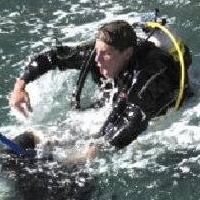
During one of my scuba classes last year, a student and I were practicing the controlled emergency swimming ascent (cesa) in the open water. We were only in 20 feet of water. The student was standing on the platform, one hand up, the other hand had a finger on the deflate button of the BCD. Everything was intact, reg in mouth, mask on...good to go. I counted down and the student took one final big breath and started heading to the surface making that famous Aaaahhhh sound. She was first looking at me, rather than looking up, so I gave her a signal to look up.
All the while, I had my hand around her BCD waist strap to help avoid a rapid ascent and slow her down if needed. She actually went a bit too slow and I helped nudge her up a bit faster before she ran out of air to exhale. Once she reached the surface, she was supposed to take a big breath, kick with her fins to stay up and orally fill her BCD with air to gain positive buoyancy.
The trip to the surface must have severely tired her because she kept wanting to breath without filling up the BCD. I told her several times to orally fill her BCD with air. I stayed close by her, but didn’t assist until I thought she needed it (I was already buoyant of course). Needless to say, she became more tired and started to sink back down. Her eyes instantly filled with panic and she thought she was going to drown. That’s when I stuck out my hand and held her up. I inflated her BCD for her and let her float a bit to regain her composure.
We talked about what happened and she thanked me for saving her life. We repeated the skill after a while and this time, as soon as she got that first breath of air from the surface (after performing the CESA from the bottom), she began orally inflating her BCD on every exhale. She was quickly buoyant and didn’t have a problem.
You may think getting to the surface after a problem underwater is all you need to do...but you’re not safe until your floating positively buoyant at the surface. All scuba divers should practice orally inflating their BCD from time to time. Get in shallow water, lift your legs off the bottom and start kicking your fins around to stay afloat. Let all the air out of your BCD and make sure your comfortable with your kick style so it properly keeps you up while you work on orally inflating your BCD. Practice that until you’re a master at it.
If you learn to first become positively buoyant when you’re at the surface (regardless of if there’s a problem or not)...you’ll help to avoid a lot of stress and possible drowning.
Sincerely,
Greg Davis
PADI Scuba Instructor
Owner of DiveBuddy.com